-
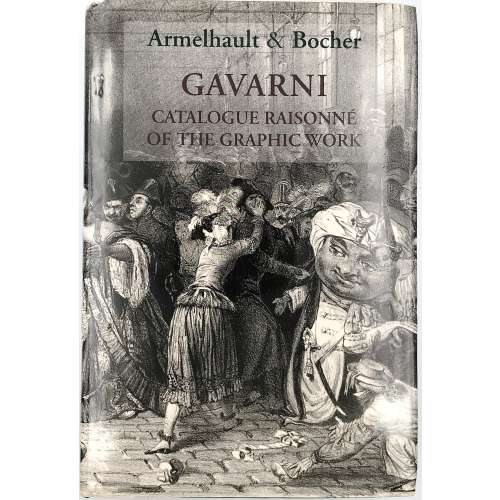 Description: Hardbound 24 x 16 x 5 cm, green cloth with gilt lettering to spine, in pictorial dust jacket. A revised re-print of L'Œuvre de Gavarni par J. Armelhault et E. Bocher. — Paris: Librairie des bibliophiles, 1873, with essays in English. Title-page: GAVARNI | CATALOGUE RAISONNÉ | OF THE GRAPHIC WORK | BY | J. ARMELHAULT & E. BOCHER | A REVISION OF THE 1873 EDITION | WITH ESSAYS IN ENGLISH | BY GORDON N. RAY | AND ROBERT J. WICKENDEN | AND SIXTY-ONE NEW PLATES | SAN FRANCISCO | ALAN WOFSY FINE ARTS | – | 2004 || Pagination: [1-4] 5-104, [i-v] vi-xiii [3] 1-627 [628]; total 374 leaves. Contributors: Paul Gavarni [Sulpice Guillaume Chevalier] (French, 1804 – 1866) Marie Joseph François Mahérault [J. Armelhault] (French, 1795 – 1879) Emmanuel Bocher (French, 1835 – 1919) Gordon Norton Ray (American, 1915 – 1986) Robert John Wickenden (British-American, 1861 – 1931)
Description: Hardbound 24 x 16 x 5 cm, green cloth with gilt lettering to spine, in pictorial dust jacket. A revised re-print of L'Œuvre de Gavarni par J. Armelhault et E. Bocher. — Paris: Librairie des bibliophiles, 1873, with essays in English. Title-page: GAVARNI | CATALOGUE RAISONNÉ | OF THE GRAPHIC WORK | BY | J. ARMELHAULT & E. BOCHER | A REVISION OF THE 1873 EDITION | WITH ESSAYS IN ENGLISH | BY GORDON N. RAY | AND ROBERT J. WICKENDEN | AND SIXTY-ONE NEW PLATES | SAN FRANCISCO | ALAN WOFSY FINE ARTS | – | 2004 || Pagination: [1-4] 5-104, [i-v] vi-xiii [3] 1-627 [628]; total 374 leaves. Contributors: Paul Gavarni [Sulpice Guillaume Chevalier] (French, 1804 – 1866) Marie Joseph François Mahérault [J. Armelhault] (French, 1795 – 1879) Emmanuel Bocher (French, 1835 – 1919) Gordon Norton Ray (American, 1915 – 1986) Robert John Wickenden (British-American, 1861 – 1931) -
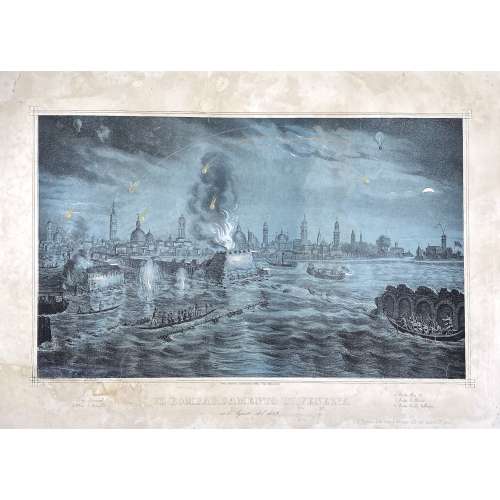 Quaritch's description: Single sheet (435 x 625 mm); coloured lithograph by Kirchmayr after a drawing by M. Fontana; hand-painted details; signed to lower left ‘M. Fon[tana]’ and to lower right ‘M. Fontana Edit. Prop. S. Giacomo dall’Orio in Isola N°.1481’; lower margin with the title ‘Il bombardamento di Venezia nell’Agosto 1849’ and key; restored tears in many places, especially along upper and lower blank margins, some affecting print; losses to lower left corner, affecting a small portion of the print, ruled border, and key, restored and re-drawn where needed; loss to the upper left corner of blank margin; two small areas of restoration to the centre of upper blank margin; the whole sheet backed; nevertheless a remarkable survival. Exceedingly rare and striking lithograph of Venice as seen from Fusina, depicting the first ever aerial bombardment in history. The bombardment took place in 1849, under the orders of Field Marshal Josef Radetzky (1766–1858), to quell the revolts that had started the previous year during the First Italian War of Independence. This curious and little-known action was the brainchild of Colonel Benno Uchatius, a brilliant young officer in the Austro-Hungarian Artillery. After long months of unsuccessful siege, Uchatius decided to deploy an unusual weapon: a hot air balloon able to bomb the city from above. Having calculated the wind speed and direction and evaluated the requisite dimensions of the hot-air balloon, Uchatius set up a workshop near Mestre, where a group of engineers and craftsmen began to manufacture a balloon equipped with a large wicker basket which could transport two crewmen and approximately one hundred kilograms of small long-fuse devices (metal spheres filled with gunpowder, pitch, oil and five hundred rifle buckshot). The initial trials, however, proved to be a disaster, because the balloon would drift off course, making it impossible to accurately deploy the bombs. Uchatius then hit upon the idea of using several smaller unmanned balloons roped together. These were to be launched over the city and, using the position of the first ‘pilot’ balloon, which was unarmed, the Austrians could calculate the correct fuse settings for the bombs. The ‘bomber’ balloons had a cloth envelope of one hundred cubic metres and a reduced load of about twenty kilograms of ordnance. According to Uchatius’ calculations, the line of balloons, launched from Mestre, would reach the lagoon city in thirty-five to forty minutes, carried by the north-west wind. In July 1849, a first launch was attempted, but when a breeze began to blow from the sea some of the balloons broke the connecting ropes and floated away, while others settled in the water in front of the northern part of the city, where a curious crowd of Venetians observed the failure of the enterprise and commented colourfully on the ‘buffoonery of Radetzky’. Uchatius’ second attempt, which is depicted in this lithograph, was also largely unsuccessful: only a few of the unmanned bomber balloons reached their target, and some even drifted back over the Austrian lines. Uchatius, having accomplished the first ever aerial bombardment, and having designed the first ever military ‘drones’, was forced to abandon the project permanently. Another fascinating aspect of this work is the vantage point used to depict the city of Venice, seen here from Fusina, a very rare viewpoint that makes this piece even more remarkable. We were unable to locate any copies in any institution or bibliography. G. Kirchmayr (fl. mid-19th century) is mentioned at British Museum database as "Lithographer active in Venice; related to Venetian painter Cherubino Kirchmayr (b. 1848)?" However, I was not able to find that name on the print. Not much is known of M. Fontana either.
Quaritch's description: Single sheet (435 x 625 mm); coloured lithograph by Kirchmayr after a drawing by M. Fontana; hand-painted details; signed to lower left ‘M. Fon[tana]’ and to lower right ‘M. Fontana Edit. Prop. S. Giacomo dall’Orio in Isola N°.1481’; lower margin with the title ‘Il bombardamento di Venezia nell’Agosto 1849’ and key; restored tears in many places, especially along upper and lower blank margins, some affecting print; losses to lower left corner, affecting a small portion of the print, ruled border, and key, restored and re-drawn where needed; loss to the upper left corner of blank margin; two small areas of restoration to the centre of upper blank margin; the whole sheet backed; nevertheless a remarkable survival. Exceedingly rare and striking lithograph of Venice as seen from Fusina, depicting the first ever aerial bombardment in history. The bombardment took place in 1849, under the orders of Field Marshal Josef Radetzky (1766–1858), to quell the revolts that had started the previous year during the First Italian War of Independence. This curious and little-known action was the brainchild of Colonel Benno Uchatius, a brilliant young officer in the Austro-Hungarian Artillery. After long months of unsuccessful siege, Uchatius decided to deploy an unusual weapon: a hot air balloon able to bomb the city from above. Having calculated the wind speed and direction and evaluated the requisite dimensions of the hot-air balloon, Uchatius set up a workshop near Mestre, where a group of engineers and craftsmen began to manufacture a balloon equipped with a large wicker basket which could transport two crewmen and approximately one hundred kilograms of small long-fuse devices (metal spheres filled with gunpowder, pitch, oil and five hundred rifle buckshot). The initial trials, however, proved to be a disaster, because the balloon would drift off course, making it impossible to accurately deploy the bombs. Uchatius then hit upon the idea of using several smaller unmanned balloons roped together. These were to be launched over the city and, using the position of the first ‘pilot’ balloon, which was unarmed, the Austrians could calculate the correct fuse settings for the bombs. The ‘bomber’ balloons had a cloth envelope of one hundred cubic metres and a reduced load of about twenty kilograms of ordnance. According to Uchatius’ calculations, the line of balloons, launched from Mestre, would reach the lagoon city in thirty-five to forty minutes, carried by the north-west wind. In July 1849, a first launch was attempted, but when a breeze began to blow from the sea some of the balloons broke the connecting ropes and floated away, while others settled in the water in front of the northern part of the city, where a curious crowd of Venetians observed the failure of the enterprise and commented colourfully on the ‘buffoonery of Radetzky’. Uchatius’ second attempt, which is depicted in this lithograph, was also largely unsuccessful: only a few of the unmanned bomber balloons reached their target, and some even drifted back over the Austrian lines. Uchatius, having accomplished the first ever aerial bombardment, and having designed the first ever military ‘drones’, was forced to abandon the project permanently. Another fascinating aspect of this work is the vantage point used to depict the city of Venice, seen here from Fusina, a very rare viewpoint that makes this piece even more remarkable. We were unable to locate any copies in any institution or bibliography. G. Kirchmayr (fl. mid-19th century) is mentioned at British Museum database as "Lithographer active in Venice; related to Venetian painter Cherubino Kirchmayr (b. 1848)?" However, I was not able to find that name on the print. Not much is known of M. Fontana either. -
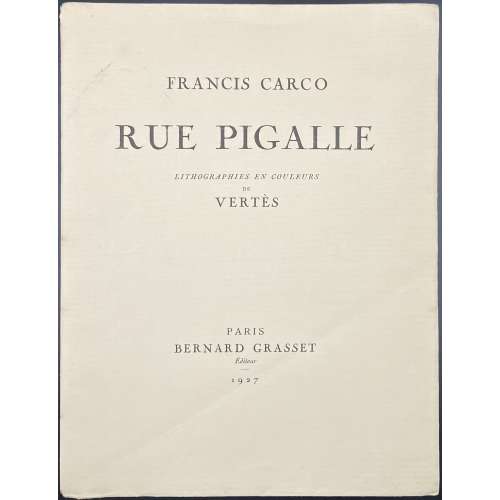 Title-page: FRANCIS CARCO | RUE PIGALLE | LITHOGRAPHIES EN COULEURS | DE | VERTÈS | PARIS | BERNARD GRASSET | Éditeur | 1927 || Description: 25.7 x 19.5 cm, French flapped cream wrappers with black lettering similar to title, lettering to spine, [2] 1st blank leaf, [2] h.t. / blank, plate / blank, [2] t.p. /blank, dedication “A | FRED ANTOINE ANGERMAYER” / blank, [1-2] d.t.p. “CHAPITRE | PREMIER” / blank, [3] 4-124, [2] limitation / blank, [2] last blank leaf; collation: 4to; π4 1-164; total 68 leaves and 14 plates printed by Frères Mourlot after watercolours by Marcel Vertès. Printing : September 15, 1927 by Coulouma in Argenteuil (H. Barthélemy, director); plates printed by Frères Mourlot in Paris; Edition: print run limited to 338 copies of which 22 on Japon Impérial (numbered Japon 1-15 and I-VII) enriched with one original watercolour drawing, one suite in black and one in colour, etc.; 43 copies on Hollande van Gelder (Hollande 1-33 and I-X) with additional suites in black and in colour; 270 copies on Vélin d’Arches (Arches 1-250 and I-XX); and 3 “special” copies. This copy is numbered Arches № 162. Contributors: Francis Carco [François Carcopino-Tusoli] (French, 1886 – 1958) – author. Marcel Vertès [Marcell Vértes] (Jewish-Hungarian-French, 1895 – 1961) – artist. Frères Mourlot – lithographer. Robert Coulouma (French, 1887 – 1976) – printer. Bernard Grasset (French, 1881 – 1955) – publisher. Fred Antoine Angermayer (German, 1889 –1951) – dedicatee. Other names: Marcel Vertès, Marcel Vertes, Marcell Vértes
Title-page: FRANCIS CARCO | RUE PIGALLE | LITHOGRAPHIES EN COULEURS | DE | VERTÈS | PARIS | BERNARD GRASSET | Éditeur | 1927 || Description: 25.7 x 19.5 cm, French flapped cream wrappers with black lettering similar to title, lettering to spine, [2] 1st blank leaf, [2] h.t. / blank, plate / blank, [2] t.p. /blank, dedication “A | FRED ANTOINE ANGERMAYER” / blank, [1-2] d.t.p. “CHAPITRE | PREMIER” / blank, [3] 4-124, [2] limitation / blank, [2] last blank leaf; collation: 4to; π4 1-164; total 68 leaves and 14 plates printed by Frères Mourlot after watercolours by Marcel Vertès. Printing : September 15, 1927 by Coulouma in Argenteuil (H. Barthélemy, director); plates printed by Frères Mourlot in Paris; Edition: print run limited to 338 copies of which 22 on Japon Impérial (numbered Japon 1-15 and I-VII) enriched with one original watercolour drawing, one suite in black and one in colour, etc.; 43 copies on Hollande van Gelder (Hollande 1-33 and I-X) with additional suites in black and in colour; 270 copies on Vélin d’Arches (Arches 1-250 and I-XX); and 3 “special” copies. This copy is numbered Arches № 162. Contributors: Francis Carco [François Carcopino-Tusoli] (French, 1886 – 1958) – author. Marcel Vertès [Marcell Vértes] (Jewish-Hungarian-French, 1895 – 1961) – artist. Frères Mourlot – lithographer. Robert Coulouma (French, 1887 – 1976) – printer. Bernard Grasset (French, 1881 – 1955) – publisher. Fred Antoine Angermayer (German, 1889 –1951) – dedicatee. Other names: Marcel Vertès, Marcel Vertes, Marcell Vértes -
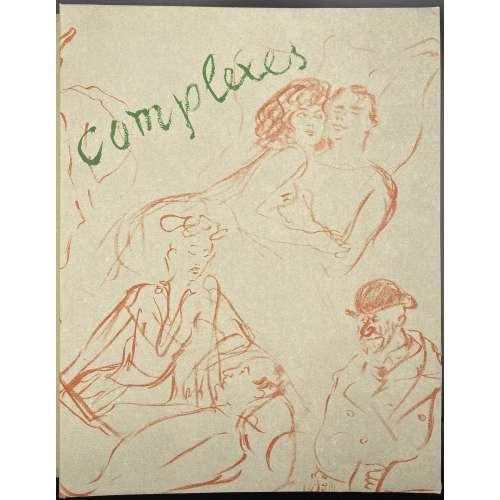 Binding: Grey double-slipcase 34 x 16.5 cm, pictorial folder, French flapped pictorial wrappers, both folder and wrapper with green ms lettering and vignette in sanguine, green ms lettering to spine. Collation: folio in-4to, two leaves in wrappers at the front and back, π8, 104 [11]2, total 50 leaves, incl. plates. Pagination: [4], [2] h.t. / limitation, [2] blank, [1-3] blank, [4-6] frontis., t.p., blank. 7-86 [2] [4] colophon, 100 pages total. Title-page (sanguine and black): COMPLEXES | 40 | DESSINS DE | Vertès | PREFACE DE | PIERRE MAC ORLAN | ANDRÉ SAURET | ÉDITIONS DU LIVRE ★ MONTE-CARLO || Illustrations: One on the front covers, one on the back one headpiece vignette, 37 plates, incl. frontispiece in colour and three on a double-page (full leaf), and one original pencil drawing. Limitation: 890 copies of which 40 (№ 1-40) signed by the artist and contain one original drawing; this copy is № 27. Edition: published by André Sauret, lithographs after Vertès drawings by Georges Duval, printed by Fernand Mourlot; text printed at “La Ruche” under the direction of A. and P. Jarach. Print run completed on November 9, 1948. Contributors: Pierre Mac-Orlan (French, 1882 – 1970) – author. Marcel Vertès [Marcell Vértes] (Jewish-Hungarian-French, 1895 – 1961) – artist. André Sauret (Monaco, fl. 1952 – 1976) – publisher. Other names: Marcel Vertès, Marcel Vertes, Marcell Vértes
Binding: Grey double-slipcase 34 x 16.5 cm, pictorial folder, French flapped pictorial wrappers, both folder and wrapper with green ms lettering and vignette in sanguine, green ms lettering to spine. Collation: folio in-4to, two leaves in wrappers at the front and back, π8, 104 [11]2, total 50 leaves, incl. plates. Pagination: [4], [2] h.t. / limitation, [2] blank, [1-3] blank, [4-6] frontis., t.p., blank. 7-86 [2] [4] colophon, 100 pages total. Title-page (sanguine and black): COMPLEXES | 40 | DESSINS DE | Vertès | PREFACE DE | PIERRE MAC ORLAN | ANDRÉ SAURET | ÉDITIONS DU LIVRE ★ MONTE-CARLO || Illustrations: One on the front covers, one on the back one headpiece vignette, 37 plates, incl. frontispiece in colour and three on a double-page (full leaf), and one original pencil drawing. Limitation: 890 copies of which 40 (№ 1-40) signed by the artist and contain one original drawing; this copy is № 27. Edition: published by André Sauret, lithographs after Vertès drawings by Georges Duval, printed by Fernand Mourlot; text printed at “La Ruche” under the direction of A. and P. Jarach. Print run completed on November 9, 1948. Contributors: Pierre Mac-Orlan (French, 1882 – 1970) – author. Marcel Vertès [Marcell Vértes] (Jewish-Hungarian-French, 1895 – 1961) – artist. André Sauret (Monaco, fl. 1952 – 1976) – publisher. Other names: Marcel Vertès, Marcel Vertes, Marcell Vértes -
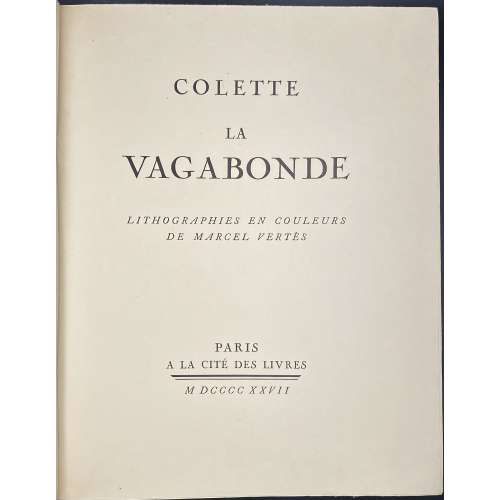 Title-page: COLETTE | LA | VAGABONDE | LITHOGRAPHIES EN COULEURS | DE MARCEL VERTÈS | PARIS | A LA CITE DES LIVRES |—| M DCCCC XXVII || Binding: French flapped wrappers 28.5 x 22.5 cm, in glassine dustcover, front wrapper lettered similarly to title-page but in red and black: COLETTE | LA | VAGABONDE | LITHOGRAPHIES EN COULEURS | DE MARCEL VERTÈS | PARIS | A LA CITE DES LIVRES |—| M DCCCC XXVII ||, in a red marbled cardboard folder 29 x 23 cm with paper label to spine, slipcase missing. Pagination: [2] 1st leaf blank, [2] h.t. / limitation, [2] t.p. / blank, [2] d.t.p. /blank, [3] 4-277 [278 blank], [4 colophon], ils. Collation: π3 1-354 χ1, plus 15 leaves of plates extraneous to collation, incl. frontispiece, chromolithographs by Marcel Vertès. Edition: Limited edition of 305 copies of which this is № 15 (out of numbers 10-24) printed on Japon Impérial paper with three additional suites of plates in black, sanguine and colour, plus 4 refused plates. Printed on the 15th of September 1927: text by Robert Coulouma (Argenteuil, director H. Barthélemy), lithographs by E. Duchatel (Paris) and published by La cité des livres. Missing black versions of LIB-2892.2021-5 and LIB-2892.2021-10 (43 out of 45 prints in place). Refused plates:
Title-page: COLETTE | LA | VAGABONDE | LITHOGRAPHIES EN COULEURS | DE MARCEL VERTÈS | PARIS | A LA CITE DES LIVRES |—| M DCCCC XXVII || Binding: French flapped wrappers 28.5 x 22.5 cm, in glassine dustcover, front wrapper lettered similarly to title-page but in red and black: COLETTE | LA | VAGABONDE | LITHOGRAPHIES EN COULEURS | DE MARCEL VERTÈS | PARIS | A LA CITE DES LIVRES |—| M DCCCC XXVII ||, in a red marbled cardboard folder 29 x 23 cm with paper label to spine, slipcase missing. Pagination: [2] 1st leaf blank, [2] h.t. / limitation, [2] t.p. / blank, [2] d.t.p. /blank, [3] 4-277 [278 blank], [4 colophon], ils. Collation: π3 1-354 χ1, plus 15 leaves of plates extraneous to collation, incl. frontispiece, chromolithographs by Marcel Vertès. Edition: Limited edition of 305 copies of which this is № 15 (out of numbers 10-24) printed on Japon Impérial paper with three additional suites of plates in black, sanguine and colour, plus 4 refused plates. Printed on the 15th of September 1927: text by Robert Coulouma (Argenteuil, director H. Barthélemy), lithographs by E. Duchatel (Paris) and published by La cité des livres. Missing black versions of LIB-2892.2021-5 and LIB-2892.2021-10 (43 out of 45 prints in place). Refused plates:
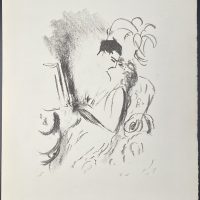

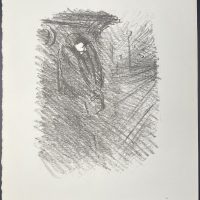 Plates in black, sanguine, and colour.
Plates in black, sanguine, and colour.


 Contributors:
Sidonie-Gabrielle Colette [a.k.a. Colette] (French, 1873 – 1954) – author.
Marcel Vertès [Marcell Vértes] (Jewish-Hungarian-French, 1895 – 1961) – artist.
Other names: Marcel Vertès, Marcel Vertes, Marcell Vértes
Contributors:
Sidonie-Gabrielle Colette [a.k.a. Colette] (French, 1873 – 1954) – author.
Marcel Vertès [Marcell Vértes] (Jewish-Hungarian-French, 1895 – 1961) – artist.
Other names: Marcel Vertès, Marcel Vertes, Marcell Vértes -
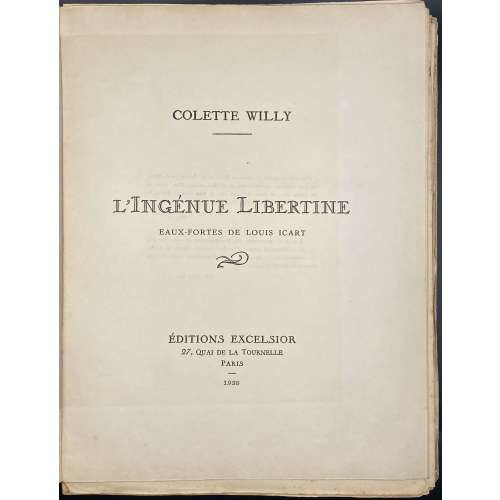 Title-page: COLETTE WILLY | — | L'ingénue libertine | EAUX-FORTES DE LOUIS ICART | ❧ | ÉDITIONS EXCELSIOR | 27, Quai de la Tournelle | Paris | 1926 || Description: French cream flapped wrappers 33.5 x 26 cm with gilt lettering to front and spine, printed on wove paper (Japon Impérial), [2] blank, [1-4] h.t. / limitation, t.p. / citations, 5-191 [3] colophon, plus 20 plates of coloured etchings and 20 plates of b/w etchings, incl. frontispiece. Edition enriched with an autograph letter signed by Colette tipped in after limitation. Edition: limited to 546 copies of which one (№ UN) is unique, printed on Papier de Chine with original colour drawings, 55 (№ 1-50 + 5 H.C.) on Japon Impérial, 65 (№ 51-100 +15 H.C.) on Hollande van Gelder, and 425 (№ 101-500 + 25 H.C.) on vergé paper BFK Rives. This copy is № 48, enriched with Colette a.l.s. and an extra suite of plates. Printed on December 3, 1926, at Arrault et Cie in Tours. Transcript of a.l.s.: "De deux romans (Minne et Les égarements de Minne) qui ne portèrent pas ma signature, j’en ai fait un seul : l’Ingénue libertine. La première partie trouve encore grâce à mes yeux ; je suis plus sévère pour la deuxième et dernière, [mot rayé] superflue et qui sent le travail. Cette libertine aurait bien dû en rester à l’ingénuité. — Colette" Contributors: Sidonie-Gabrielle Colette [a.k.a. Colette] (French, 1873 – 1954) – author. Henry Gauthier-Villars [a.k.a. Willy] (French, 1859 – 1931) – author. Louis Icart (French, 1888 – 1950) – artist.
Title-page: COLETTE WILLY | — | L'ingénue libertine | EAUX-FORTES DE LOUIS ICART | ❧ | ÉDITIONS EXCELSIOR | 27, Quai de la Tournelle | Paris | 1926 || Description: French cream flapped wrappers 33.5 x 26 cm with gilt lettering to front and spine, printed on wove paper (Japon Impérial), [2] blank, [1-4] h.t. / limitation, t.p. / citations, 5-191 [3] colophon, plus 20 plates of coloured etchings and 20 plates of b/w etchings, incl. frontispiece. Edition enriched with an autograph letter signed by Colette tipped in after limitation. Edition: limited to 546 copies of which one (№ UN) is unique, printed on Papier de Chine with original colour drawings, 55 (№ 1-50 + 5 H.C.) on Japon Impérial, 65 (№ 51-100 +15 H.C.) on Hollande van Gelder, and 425 (№ 101-500 + 25 H.C.) on vergé paper BFK Rives. This copy is № 48, enriched with Colette a.l.s. and an extra suite of plates. Printed on December 3, 1926, at Arrault et Cie in Tours. Transcript of a.l.s.: "De deux romans (Minne et Les égarements de Minne) qui ne portèrent pas ma signature, j’en ai fait un seul : l’Ingénue libertine. La première partie trouve encore grâce à mes yeux ; je suis plus sévère pour la deuxième et dernière, [mot rayé] superflue et qui sent le travail. Cette libertine aurait bien dû en rester à l’ingénuité. — Colette" Contributors: Sidonie-Gabrielle Colette [a.k.a. Colette] (French, 1873 – 1954) – author. Henry Gauthier-Villars [a.k.a. Willy] (French, 1859 – 1931) – author. Louis Icart (French, 1888 – 1950) – artist. -
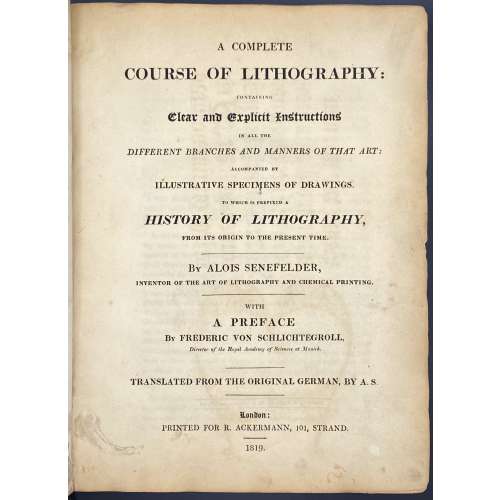 Title: A COMPLETE | COURSE OF LITHOGRAPHY: | CONTAINING | Clear and Explicit Instructions | IN ALL THE | DIFFERENT BRANCHES AND MANNERS OF THAT ART | ACCOMPANIED BY | ILLUSTRATIVE SPECIMENS OF DRAWINGS. | TO WHICH IS PREFIXED A | HISTORY OF LITHOGRAPHY, | FROM ITS ORIGIN TO THE PRESENT TIME. | By ALOIS SENEFELDER, | INVENTOR OF THE ART OF LITHOGRAPHY AND CHEMICAL PRINTING. | WITH | A PREFACE | By FREDERIC VON SCHLICHTEGROLL, |Director of the Royal Academy of Sciences at Munich. | TRANSLATED FROM THE ORIGINAL GERMAN, BY A.S. | London: | PRINTED FOR R. ACKERMANN, 101 STRAND. | 1819. || Pagination: [i-iii] iv-xxviii, [4] [1] 2-342. Collation: 4to; [a]-d4, B-2U4 2X2, +14 lithographed plates by Ackermann (incl. 1 folding, 1 colour frontispiece and 1 portrait of A. Senefelder); plates opposite to pp. [i], [1], 193, 198, 203, 228, 232 (fold.), 256, 258, 264, 269, 290, 302, and 305. Binding: By Anne Krawitz (Philadelphia, PA), 27.5 x 21 cm, modern full mottled calf, boards ruled in gilt, flat spine, compartments ruled in gilt, crimson label with gilt lettering to spine, printed on wove paper; round book-plate to front paste-down “TWM, The Whitehead Library”. Edition: 1st in English. Ref.: MET: Accession Number: Ref.20; RCT: RCIN 1195886; Contributors: Alois Senefelder (German, 1771 – 1834) – author of the original and translator. Friedrich Schlichtegroll (German, 1765 – 1822) – author of preface. William Clowes (British, 1779 – 1847) – printer. Rudolph Ackermann (German-British, 1764 – 1834) – publisher and lithographer. Samuel Prout (British, 1783 – 1852) Maximilian Joseph, King of Bavaria (German, 1756 –1825) – dedicatee.
Title: A COMPLETE | COURSE OF LITHOGRAPHY: | CONTAINING | Clear and Explicit Instructions | IN ALL THE | DIFFERENT BRANCHES AND MANNERS OF THAT ART | ACCOMPANIED BY | ILLUSTRATIVE SPECIMENS OF DRAWINGS. | TO WHICH IS PREFIXED A | HISTORY OF LITHOGRAPHY, | FROM ITS ORIGIN TO THE PRESENT TIME. | By ALOIS SENEFELDER, | INVENTOR OF THE ART OF LITHOGRAPHY AND CHEMICAL PRINTING. | WITH | A PREFACE | By FREDERIC VON SCHLICHTEGROLL, |Director of the Royal Academy of Sciences at Munich. | TRANSLATED FROM THE ORIGINAL GERMAN, BY A.S. | London: | PRINTED FOR R. ACKERMANN, 101 STRAND. | 1819. || Pagination: [i-iii] iv-xxviii, [4] [1] 2-342. Collation: 4to; [a]-d4, B-2U4 2X2, +14 lithographed plates by Ackermann (incl. 1 folding, 1 colour frontispiece and 1 portrait of A. Senefelder); plates opposite to pp. [i], [1], 193, 198, 203, 228, 232 (fold.), 256, 258, 264, 269, 290, 302, and 305. Binding: By Anne Krawitz (Philadelphia, PA), 27.5 x 21 cm, modern full mottled calf, boards ruled in gilt, flat spine, compartments ruled in gilt, crimson label with gilt lettering to spine, printed on wove paper; round book-plate to front paste-down “TWM, The Whitehead Library”. Edition: 1st in English. Ref.: MET: Accession Number: Ref.20; RCT: RCIN 1195886; Contributors: Alois Senefelder (German, 1771 – 1834) – author of the original and translator. Friedrich Schlichtegroll (German, 1765 – 1822) – author of preface. William Clowes (British, 1779 – 1847) – printer. Rudolph Ackermann (German-British, 1764 – 1834) – publisher and lithographer. Samuel Prout (British, 1783 – 1852) Maximilian Joseph, King of Bavaria (German, 1756 –1825) – dedicatee. -
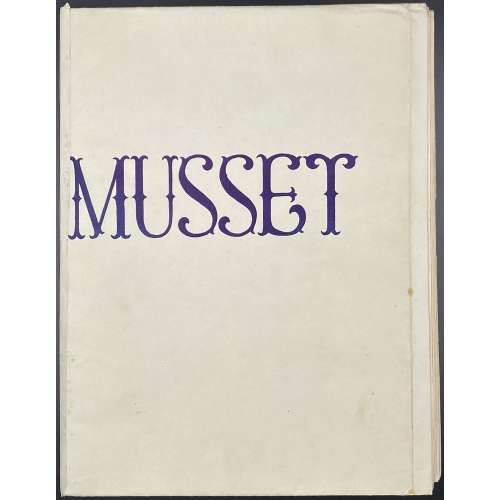 Description: one volume in French flapped wrappers 25.3 x 19 cm, lettered “MUSSET” to front, 5 gatherings of 4 and one of 6 leaves, 26 leaves total, pp.: [4] [2] 3-43 [44] [4], total 52 pages, incl. those in wrappers, unbound; plus coloured and uncoloured suites of 12 lithographs, in a paper folder; in a cardboard tan slipcase 2.8 x 19.3 cm. Artist unknown, publisher unknown, published at the end of 1940s (per J.-P. Dutel). Illustrations are a loose interpretation of original lithographs by Devéria and Henri Grévedon or Octave Tassaert for the 1833 edition ((1926 re-print LIB-3135.2023). Limitation: Edition limited to 250 copies printed on Vélin Chiffon numbered 1 -250 and 24 copies marked by letters A to Z. This is copy № 246, with two suites of plates, one coloured and one b/w. Catalogue raisonné: Dutel (1920-1970) № 1657, p. 189. Alfred de Musset (French, 1810 – 1857) – author.
Description: one volume in French flapped wrappers 25.3 x 19 cm, lettered “MUSSET” to front, 5 gatherings of 4 and one of 6 leaves, 26 leaves total, pp.: [4] [2] 3-43 [44] [4], total 52 pages, incl. those in wrappers, unbound; plus coloured and uncoloured suites of 12 lithographs, in a paper folder; in a cardboard tan slipcase 2.8 x 19.3 cm. Artist unknown, publisher unknown, published at the end of 1940s (per J.-P. Dutel). Illustrations are a loose interpretation of original lithographs by Devéria and Henri Grévedon or Octave Tassaert for the 1833 edition ((1926 re-print LIB-3135.2023). Limitation: Edition limited to 250 copies printed on Vélin Chiffon numbered 1 -250 and 24 copies marked by letters A to Z. This is copy № 246, with two suites of plates, one coloured and one b/w. Catalogue raisonné: Dutel (1920-1970) № 1657, p. 189. Alfred de Musset (French, 1810 – 1857) – author. -
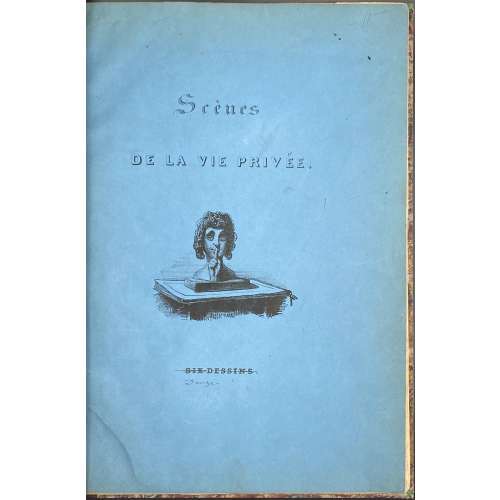 Pictorial album 31 x 22.8 cm, bound in quarter red calf over marbled boards with gilt lettering “SCÈNES | DE | LA VIE | PRIVÉE” and gilt ornament to spine; marbled endpapers, flyleaf, blue original wrapper (title-page) lettered SCÈNES | DE LA VIE PRIVÉE. | {vignette} | SIX DESSINS || «Six dessins» struck out, ms inscription beneath “Douze”. Twelve hand-coloured lithographs, some inscribed with letters and/or numbers in reverse, each in a double-rule frame 22 x 16.5 cm, images 18 x 14.5 cm (approx.); series title “Scènes de la vie intime” printed above the frame, image title printed in the lower compartment; ms numbers above the upper-right corner of the frame (state before sequential numbers, ms numbers do not correspond with artist numbering). Flyleaf at the end. Two bookplates to front pastedown: “EX-LIBRIS PAUL GAVAULT” and armorial “IN ROBORE ROBUR | Ex Libris Bourlon de Rouvre”. Content (Roman numerals in parenthesis are publisher's numbers; numerals in italic are Armelhault-Bocher reference numbers):
Pictorial album 31 x 22.8 cm, bound in quarter red calf over marbled boards with gilt lettering “SCÈNES | DE | LA VIE | PRIVÉE” and gilt ornament to spine; marbled endpapers, flyleaf, blue original wrapper (title-page) lettered SCÈNES | DE LA VIE PRIVÉE. | {vignette} | SIX DESSINS || «Six dessins» struck out, ms inscription beneath “Douze”. Twelve hand-coloured lithographs, some inscribed with letters and/or numbers in reverse, each in a double-rule frame 22 x 16.5 cm, images 18 x 14.5 cm (approx.); series title “Scènes de la vie intime” printed above the frame, image title printed in the lower compartment; ms numbers above the upper-right corner of the frame (state before sequential numbers, ms numbers do not correspond with artist numbering). Flyleaf at the end. Two bookplates to front pastedown: “EX-LIBRIS PAUL GAVAULT” and armorial “IN ROBORE ROBUR | Ex Libris Bourlon de Rouvre”. Content (Roman numerals in parenthesis are publisher's numbers; numerals in italic are Armelhault-Bocher reference numbers):- Titre de la couverture (Title-page) – 2001
- (III) Un nid dans les blés (A nest in the wheat) – 2004
- (II) Amitié de pension (Friendship in the pension) – 2003
- (XI) Bras dessus, bras dessous (Arm up, arm down) – 2012
- (I) Causerie (Chat) – 2002
- (VI) Prélude (Prelude) – 2007
- (IX) Le guet-apens (Ambush) – 2010
- (V) Le cabinet noir (The dark chamber) – 2006
- (IV) Distraction (Entertainment) – 2005
- (X) Leçon de paysage (Landscape lesson) – 2011
- (VII) Avant le péché (Before sin) – 2008
- (VIII) Après le péché (After sin) – 2009
- (XII) La femme du peintre (The painter's wife) – 2013
-
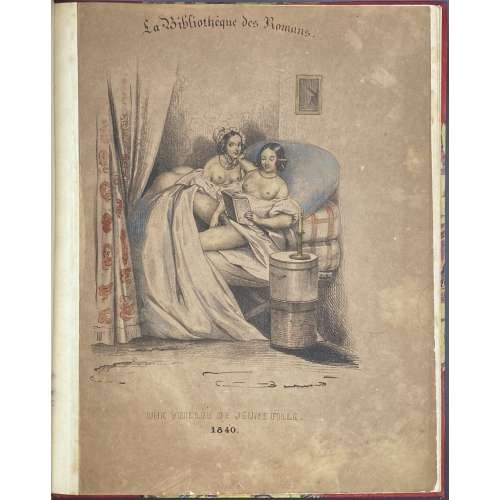 Description: Pictorial album 29.7 x 24 cm, bound in ¾ red morocco over marbled boards with gilt lettering “LA BIBLIOTHÈQUE DES ROMANS” and raised bands to spine; marbled endpapers, two flyleaves, tan original wrapper lettered “La Bibliothèque des Romans. (gothic, arch) | {colour vignette} | UNE VEILLÉE DE JEUNE FILLE. | 1840. || Six hand-coloured lithographs, each in a double-rule border with the series title above it and image title below. Sequential numbers are hand-inscribed within the border in the upper-right corner. Frame 23.5 x 18.3 cm, image 21.5 x 16.5 cm. Three flyleaves at the end. A bookplate to front pastedown: “GERARD NORDMANN EX-LIBRIS”. Content:
Description: Pictorial album 29.7 x 24 cm, bound in ¾ red morocco over marbled boards with gilt lettering “LA BIBLIOTHÈQUE DES ROMANS” and raised bands to spine; marbled endpapers, two flyleaves, tan original wrapper lettered “La Bibliothèque des Romans. (gothic, arch) | {colour vignette} | UNE VEILLÉE DE JEUNE FILLE. | 1840. || Six hand-coloured lithographs, each in a double-rule border with the series title above it and image title below. Sequential numbers are hand-inscribed within the border in the upper-right corner. Frame 23.5 x 18.3 cm, image 21.5 x 16.5 cm. Three flyleaves at the end. A bookplate to front pastedown: “GERARD NORDMANN EX-LIBRIS”. Content:- Front wrapper (title-page)
- SŒUR ANNE (Sister Anne)
- LA GRISETTE (The grisette)
- LÉONIDE OU LA VIEILLE DE SURÊNE (Léonide or the old lady of Surêne)
- LA PUCELLE DE BELLEVILLE (The maid of Belleville)
- MON VOISIN RAYMOND (My neighbor Raymond)
- LE COCU (The cuckold)


